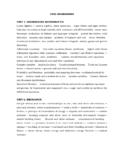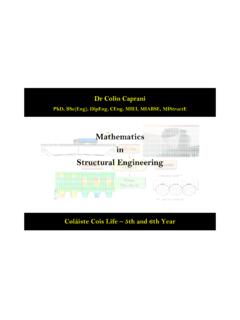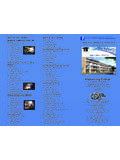Transcription of Advanced Mathematics for Engineers - HS …
1 Advanced Mathematics for EngineersWolfgang Erteltranslated by Elias Drotleff and Richard CubekOctober 1, 2012 PrefaceSince 2008 this Mathematics lecture is offered for the master courses computer science,mechatronics and electrical engineering . After a repetition of basic linear algebra, computeralgebra and calculus, we will treat numerical calculus, statistics and function approximation,which are the most important Mathematics basic topics for also provide an introduction to Computer Algebra. Mathematica, Matlab and Octaveare powerful tools for the Exercises. Event though we favour the open source tool Octave,the student is free to choose either one of the are looking forward to work with interesting semesters with many motivated and eagerstudents who want to climb up the steep, high and fascinating mountain of engineeringmathematics together with us. I assure you that we will do our best to guide you throughthe sometimes wild, rough and challenging nature of Mathematics .
2 I also assure you that allyour efforts and your endurance in working on the exercises during nights and weekends willpay off as good marks and most importantly as a lot of though we repeat some undergraduate linear algebra and calculus, the failure ratein the exams is very high, in particular among the foreign students. As a consequence, westrongly recommend all our students to repeat undergraduate linear algebra such as operationon matrices like solution of linear systems, singularity of matrices, inversion, eigenvalueproblems, row-, column- and nullspaces. You also should bring decent knowledge of one-dimensional and multidimensional calculus, differentiation and integration in one andmany variables, convergence of sequences and series and finding extrema with constraints ofmultivariate functions. And basic statistics is also required. To summarize:If you are notable to solve problems (not only know the terms) in these fields, you have verylittle chances to successfully finish this of this CourseThe first version of this script was created in the winter semester 95/96.
3 I had included inthis lecture only Numerics, although I wanted to cover initially Discrete Mathematics too,which is very important for computer scientists. If you want to cover both in a lecture ofthree semester week hours, it can happen only superficially. Therefore I decided to focus likemy colleagues on Numerics. Only then it is possible to impart profound Numerical Calculus besides the basics, systems of linear equations, various interpola-tion methods, function approximation, and the solution of nonlinear equations will be pre-sented. An excursion into applied research follows, where in the field of benchmarkingof Microprocessors, Mathematics (functional equations) is influencing directly the practiceof computer summer 1998 a chapter about Statistics was added, because of the weak coverage atour University till then. In the winter semester 1999/2000, the layout and structure wereimproved, as well some mistakes have been the context of changes in the summer semester 2002 in the curriculum of Applied Computerscience, statistics was shifted, because of the general relevance for all students, into the lectureMathematics 2.
4 Instead of Statistics, contents should be included, which are specificallyrelevant for computer scientists. The generation and verification of random numbers is animportant topic, which is finally also summer 2008, this lecture is only offered to Master (Computer Science) the chapter about random numbers was extended. Maybe other contents will beincluded in the lecture. For some topics original literature will be handed out, then studenthave to prepare the material by the winter semester 2010/11 the lecture has now been completely revised, restructuredand some important sections added such as radial basis functions, Gaussian processes andstatistics and probability. These changes become necessary with the step from Diplomato Master. I want to thank Markus Schneider and Haitham Bou Ammar who helped meimprove the the winter semester 2010/11 the precourse will be integrated in the lecture in order togive the students more time to work on the exercises.
5 Thus, the volume of lecture growsfrom 6 SWS to 8 SWS and we will now split it into two lectures of 4 SWS the winter semester 2012/13 we go back to a one semester schedule with 6 hours per weekfor computer science and mechatronics students. Electrical engineering students will only gofor four hours, covering chapters one to ErtelContents1 Linear Video Lectures .. Exercises ..32 Computer Symbol Processing on the Computer .. Short Introduction to Mathematica .. Gnuplot, a professional Plotting Software .. Short Introduction to MATLAB .. Short Introduction to GNU Octave .. Exercises ..303 Calculus Selected Sequences and Convergence .. Series .. Continuity .. Taylor Series .. Differential Calculus in many Variables .. Exercises ..654 Statistics and Probability Recording Measurements in Samples .. Statistical Parameters .. Multidimensional Samples.
6 Probability Theory .. Discrete Distributions .. Continuous Distributions .. Exercises ..855 Numerical Mathematics Arithmetics on the Computer .. Numerics of Linear Systems of Equations .. Roots of Nonlinear Equations .. Exercises .. 1106 Function Polynomial Interpolation .. Spline interpolation .. Method of Least Squares and Pseudoinverse .. Exercises .. 1372 CONTENTS7 Statistics and Random Numbers .. Calculation of Means - An Application for Functional Equations .. Exercises .. Principal Component Analysis (PCA) .. Estimators .. Gaussian Distributions .. Maximum Likelihood .. Linear Regression .. Exercises .. 1778 Function Linear Regression Summary .. Radial Basis Function Networks .. Clustering .. Singular Value Decomposition and the Pseudo-Inverse.
7 Exercises .. 1979 Numerical Integration and Solution of Ordinary Differential Equations Numerical Integration .. Numerical Differentiation .. Numerical Solution of Ordinary Differential Equations .. Linear Differential Equations with Constant Coefficients .. Exercises .. 219 Bibliography224 Chapter 1 Linear Video LecturesWe use the excellent video lectures from G. Strang, the author of [1], available from: In particularwe show the following lectures:Lec#Topics1 The geometry of linear equations (lecture 01)2 Transposes, Permutations, SpacesRn(lecture 05)3 Column Space and Nullspace (lecture 06)4 Solving Ax = 0: Pivot Variables, Special Solutions (lecture 07)5 Independence, Basis, and Dimension (lecture 09)6 The Four Fundamental Subspaces (lecture 10)7 Orthogonal Vectors and Subspaces (lecture 14)8 Properties of Determinants (lecture 18)9 Determinant Formulas and Cofactors (lecture 19)10 Cramer s rule, inverse matrix, and volume (lecture 20)11 Eigenvalues and Eigenvectors (lecture 21)12 Symmetric Matrices and Positive Definiteness (lecture 25)13 Linear Transformations and Their Matrices (lecture 30) ExercisesExercise the nonsingular triangular systemu+v+w=b1( )v+w=b2( )w=b3( )Show that your solution gives a combination of the columns that equals the column on why the systemu+v+w= 2( )u+ 2v+ 3w= 1( )v+ 2w= 0( )41 Linear Algebrais singular, by finding a combination of the three equations that adds up to 0 = 1.
8 Whatvalue should replace the last zero on the right side, to allow the equations to have solutions,and what is one of the solutions?Inverses and TransposesExercise properties of a matrixAare preserved by its inverse (assumingA 1exists)?(1)Ais triangular(2)Ais symmetric(3)Ais tridiagonal(4) all entries are whole numbers(5) all entries are fractions (including whole numbers like31)Exercise )How many entries can be chosen independently, in a symmetric matrix of ordern?b)How many entries can be chosen independently, in a skew-symmetric matrix of ordern?Permutations and EliminationExercise )Find a square 3 3 matrixP, that multiplied from left to any 3 mmatrixAexchangesrows 1 and )Find a squaren nmatrixP, that multiplied from left to anyn permutation is a bijective mapping from a finite set onto itself. Appliedto vectors of lengthn, a permutation arbitrarily changes the order of the vector compo-nents. The word ANGSTBUDE is a permutation of BUNDESTAG.
9 An example of apermutation on vectors of length 5 can be described by(3,2,1,5,4).This means component 3 moves to position 1, component 2 stays where it was, component1 moves to position 3, component 5 moves to position 4 and component 4 moves to )Give a 5 5 matrixPthat implements this )How can we come from a permutation matrix to its inverse?Exercise )Find a 3 3 matrixE, that multiplied from left to any 3 mmatrixAadds 5 times row2 to row )Describe an nmatrixE, that multiplied from left to anyn mmatrixAaddsktimesrowito )Based on the above answers, prove that the elimination process of a matrix can be realizedby successive multiplication with matrices from Exercises5 Column Spaces and NullSpacesExercise of the following subsets ofR3are actually subspaces?a)The plane of vectors with first componentb1= )The plane of vectorsbwithb1= )The vectorsbwithb1b2= 0 (this is the union of two subspaces, the planeb1= 0 and theplaneb2= 0).
10 D)The solitary vectorb= (0,0,0).e)All combinations of two given vectorsx= (1,1,0) andy= (2,0,1).f )The vectors (b1,b2,b3) that satisfyb3 b2+ 3b1= the plane in 3-space with equationx+ 2y+z= 6. What is theequation of the planeP0through the origin parallel toP? ArePandP0subspaces ofR3?Exercise descriptions are correct? The solutionsxofAx=[1 1 11 0 2] x1x2x3 =[00]( )form a plane, line, point, subspace, nullspace ofA, column space 0and Pivot VariablesExercise the matrixA=[0 1 4 00 2 8 0]( )determine the echelon formU, the basic variables, the free variables, and the general solutiontoAx= 0. Then apply elimination toAx=b, with componentsb1andb2on the right side;find the conditions forAx=bto be consistent (that is, to have a solution) and find thegeneral solution in the same form as Equation (3). What is the rank ofA?Exercise the general solution to[1 2 22 4 5] uvw =[14]( )as the sum of a particular solution toAx=band the general solution toAx= 0, as in (3).






